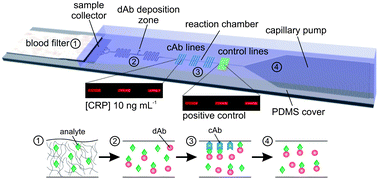Point-of-care diagnostics will strongly benefit from miniaturization based on microfluidics because microfluidics integrate functions that can together preserve valuable samples and reagents, increase sensitivity of a test, and accelerate mass transport limited reactions. But a main challenge is to incorporate reagents into microfluidics and to make microfluidics simple to use. Here, we integrate microfluidic functional elements, some of which were developed earlier, and reagents such as detection antibodies (dAbs), capture antibodies (cAbs) and analyte molecules for making one-step immunoassays: the integrated device only requires the addition of sample to trigger a cascade of events powered by capillary forces for effecting a sandwich immunoassay that is read using a fluorescence microscope. The microfluidic elements comprise a sample collector, delay valves, flow resistors, a deposition zone for dAbs, a reaction chamber sealed with a polydimethylsiloxane (PDMS) substrate, and a capillary pump and vents. Parameters for depositing 3.6 nL of a solution of dAb on the chip using an inkjet are optimized and the PDMS substrate is patterned with analytes, which provide a positive control, and cAbs. Various storage conditions of the patterned PDMS are investigated for up to 6 months revealing that storage with a desiccant preserved at least 51% of the activity of the cAbs. C-reactive protein (CRP), a general inflammation and cardiac marker, is detected using this one-step chip using only 5 µL of human serum by measuring fluorescent signals from 30 × 100 µm2 areas of the PDMS substrate in the wet reaction chamber. The one-step chip can detect CRP at a concentration of 10 ng mL−1 in less than 3 min and below 1 ng mL−1 within 14 min. The work presented here may spur the adoption of fluorescence immunoassays using capillary driven microfluidics and PDMS substrates for point-of-care diagnostics.

You have access to this article
 Please wait while we load your content...
Something went wrong. Try again?
Please wait while we load your content...
Something went wrong. Try again?


 Please wait while we load your content...
Please wait while we load your content...